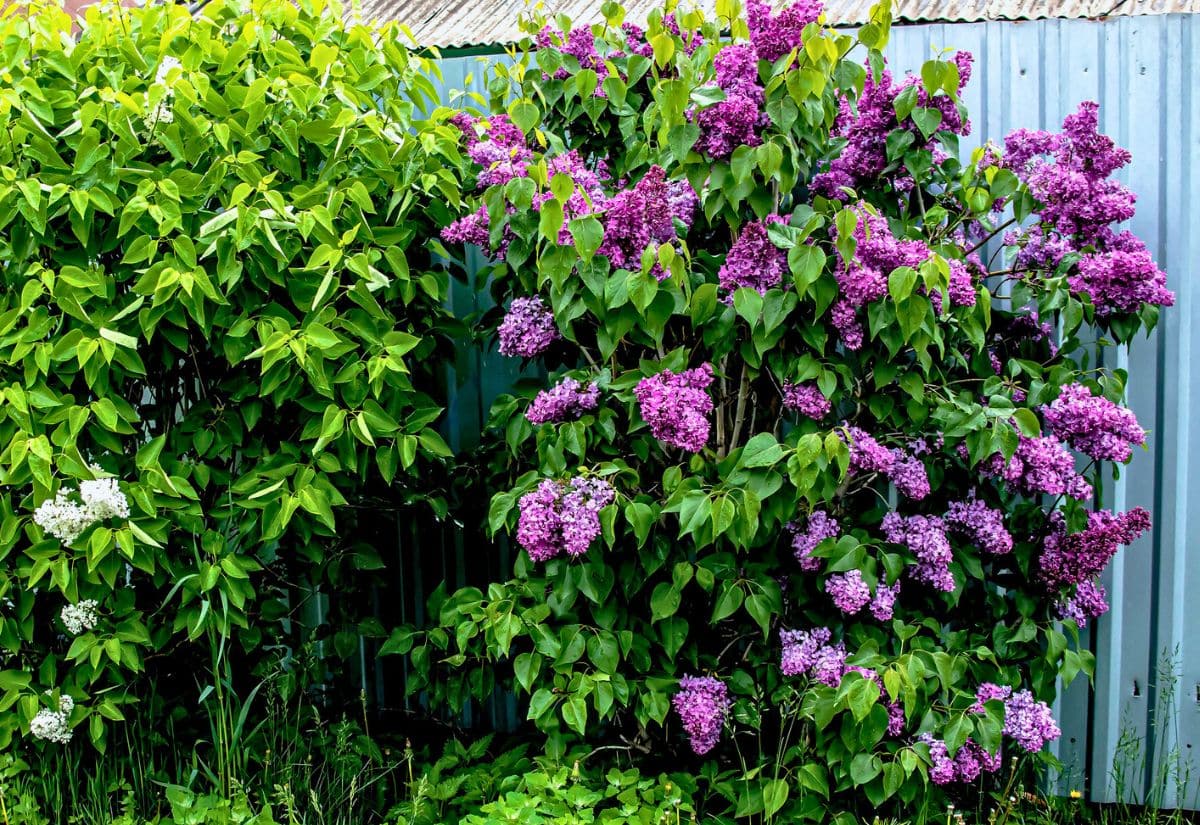
Dreaming of the most stunning lilac blooms this year? It’s time to give your bushes some springtime TLC for peak health and a season of spectacular growth!
As spring approaches, we all wait with trepidation for the impressive blooms that our bushy lilacs will soon give us, taking up the star role in our gardens! Generous, sturdy and cold hardy, this shrub never disappoints, unless you make mistakes, but Syringa’s blossoms can literally wow you if you know how to treat it, and you give it some tender loving care as the new season starts!
To make sure your lilac shrubs display some seriously impressive blooms this spring, there are dome dos and don’ts you need to follow, and I also have a few tips, a few, but easy steps to take in late winter or spring, so that their amazing flowers will light up your garden with their vibrant colors and light-filled energy! Just follow me…
1: Feed Your Lilacs Early in the Season to Give Them the Energy They Need for Massive Blooms in Spring and Early Summer
The flowering season for lilacs usually starts in April and it ends in June, and their buds need lots of energy, so, you need to fertilize your Syring bushes in late winter or early spring! Lack of nutrients at this stage will affect their ability to blossom with their legendary vigor. And you need to give them at least one or two months of feeding to keep them strong and healthy.
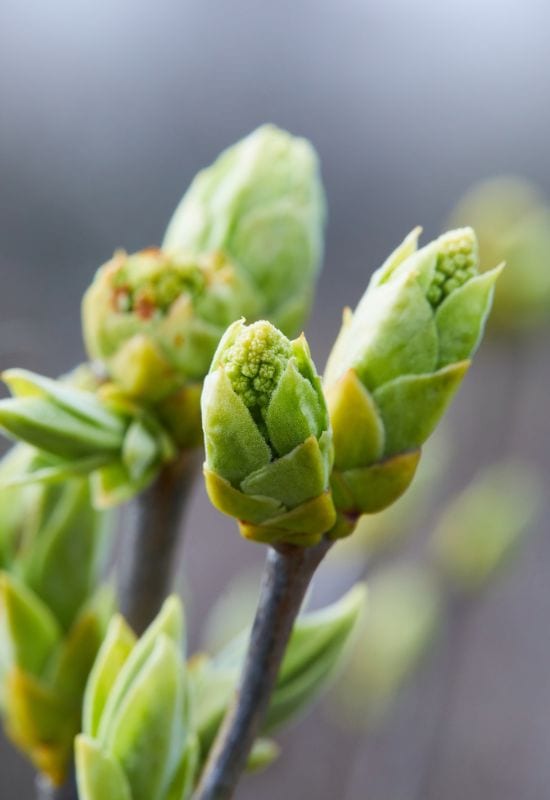
The exact season may depend on your climate zone, in hot countries, lilacs can blossom quite early, but they are cold hardy to USDA zone 3, which is quite freezing, and there, you may need to wait a few weeks longer. But it will be worthwhile. What matters is that you wait till your Syringa shrubs have come out of dormancy to fertilize them.
You will know that the time has come to feed lilacs because you will see the first leaf buds starting. Don’t do it before, or you may encourage these flowering shrubs to start too early, and the foliage may suffer from frost.
But don’t wait too long either! As soon as your lilac wakes up, fertilize it abundantly, it is at this stage that it needs a boost of energy, and if you wait till just before it blossoms, it may be too late.
Now, let’s see how to feed your lilacs.
How to Fertilize Your Lilacs with Compost in Spring for Impressive Blooms
The easiest way to fertilize lilacs is to use compost. Just place a 1-inch-thick layer (2.5 cm) on the soil and leave it there to seep into the ground. You can speed up the process by watering it, but don’t overwater, especially if the season is wet, in case, just let rainfalls do the job for you.
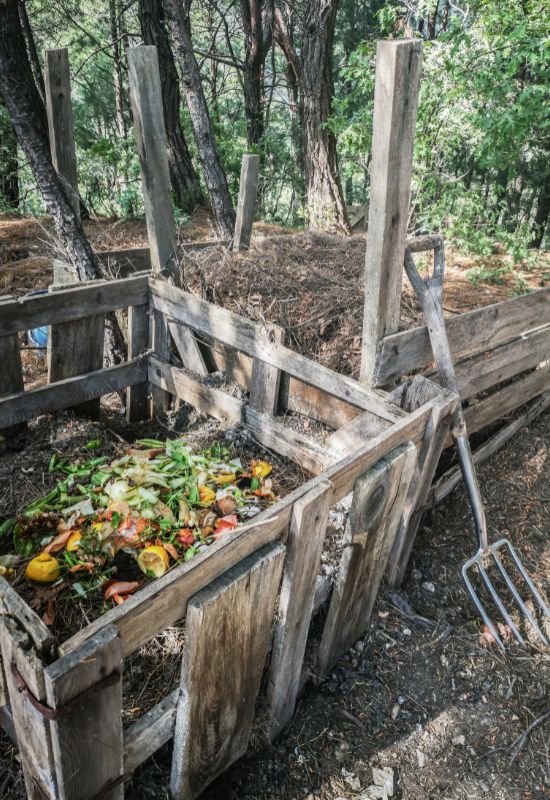
Make sure you cover all the area at the base of the lilac shrub, reaching the dripline, which is the extension of the furthers branch, just drop an imaginary line from there, and compost to that point at least.
With compost, you need to start as soon as possible (when you see the first leaf buds), because it takes time to seep into the soil, and it is a slow-release fertilizer.
If you had mulched your lilacs, you can remove it temporarily, and then lay it down again. Your compost will seep through anyway, more easily if you have used wood chippings or bark, than with straw, for example, but it still will.
How to Feed Your Lilacs with Off-the-Peg Organic Slow-Release Fertilizers in Spring to Get Massive Blooms
Of course, there are many off the peg slow-release fertilizers you can use to feed your lilacs in spring, apart from compost, and they too will help your flowering shrubs blossom profusely. Choose an organic product, and with an NPK of 10-10-10 or 14-14-14. Again, give it as soon as you see the new leaf buds.
Some gardeners suggest choosing one with a higher phosphorus ratio (the “P”, which boosts flowers and fruits), just because lilacs give us huge blossoms. I wouldn’t be fully against it, but never push it to more than 10-15-10. True, Syringa bushes give colossal blooms, but they also need the leaves (so, nitrogen, or “N”) and strong roots (or potassium, “K2) to sustain this massive floral effort.
Maybe, if your lilac underperformed las year, and you did everything right, then you could try giving it a bit of extra phosphorus.
But lilacs are hungry shrubs in spring, because they grow so much in terms of ranches, leaves and flowers, and in such a short time. So, while with most perennials and smaller bushes you could feed them half a dose, with Syringa I suggest full meal, the full dosage, as indicated on the package!
Scatter it as evenly as possible around the base of your lilac shrubs, again, keeping the dripline as a measure.
Water your lilac shrubs after you have given them the slow-release organic fertilizer, and this will help it seep into the soil and become available to your lilac’s roots.
Can You Use Fast-Release Fertilizers with Lilacs in Spring, and Will It Give You Big Blooms?
Fast-release fertilizers are not ideal for shrubs, trees and perennials, but if you have waited too long, and you have not fed your lilacs with a slow-release one, you could try to save the day with it – but you won’t get the same results with blooms. Still, Syringa is very generous, so, it won’t leave your garden flowerless.
In case, use the same NPK (10-10-10 or 14-14-14) as with slow-release fertilizers, but you need to dilute it in water. Make sure you put maximum one part of fertilizer for every 10 parts of water. Next…
2: Improve Soil Drainage in Spring to Get Huge Blooms from Your Lilacs
Well drained soil is essential to have great blossoms and healthy lilac shrubs – and spring is the time to improve it! In fact, Syringa can suffer if its roots are wet and the soil is waterlogged, becoming ill and giving you underwhelming floral displays.
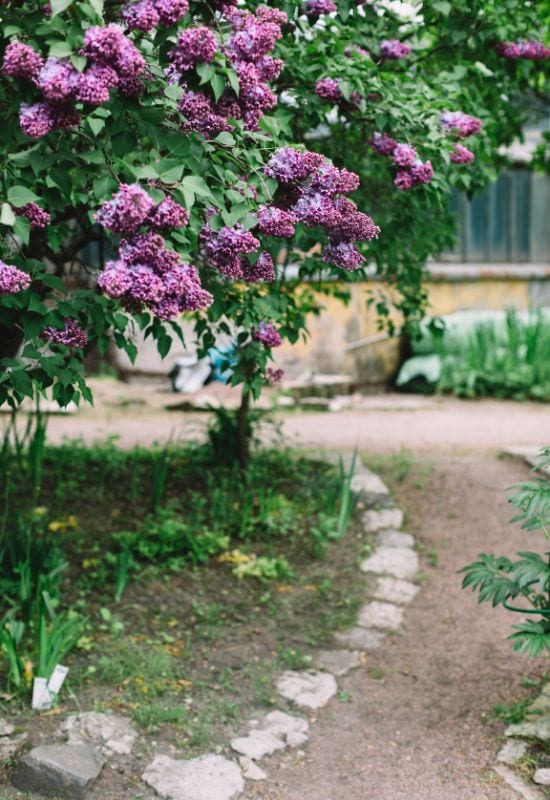
Remember that harsh winters and heavy rainfall can negatively affect the drainage of your soil, so, spring is the time to act.
For most soils, you can use coarse sand to improve drainage, about one inch (2.5 cm) all around d the lilac shrub, minimum to the dripline, but ideally a good foot or two (30 to 60 cm) past it. Just scatter it on the soil, as evenly as you can, and maybe use a rake to even it out. Do it before you water, so it will seep into the soil faster.
However, in case your soil is heavy clay, sand won’t be enough. You will have to use
If you have mulched your lilacs, don’t worry. You can remove t temporarily if you wish, and then lay it again, but coarse sand will need gypsum. You will need to lay 1 to 2 pounds per square meter (500 to 1,000 grams). Unfortunately, it is quite expensive, about £50 for a 25 Kg bag…
You don’t need to dig it in, just let it penetrate the soil with waterings and rainfall. However, as an extra tip, ideally, I would start in late winter with improving soil drainage, so it is good by the time you start watering and feeding your lilacs.
3: Do NOT Prune Your Lilac Shrubs in Spring – You Will Cut the Flower Buds!
Pruning lilac shrubs in spring is a big mistake, because you would be cutting off their flower buds! Yes, it takes them a lot of time to produce their massive floral displays, and in fact, they start as early as summer!
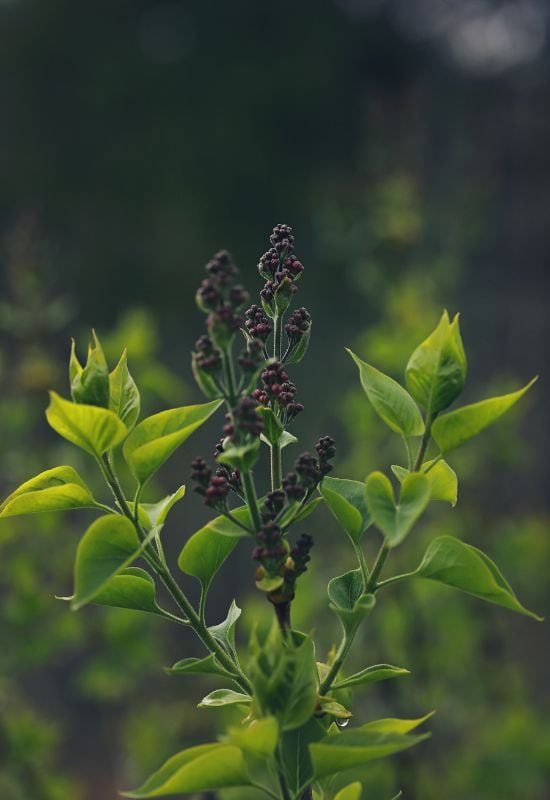
Even if you cannot see them, lilacs are already starting to grow new buds for that burst of color, energy and blossoms after the bloom is spent! So, only prune Syringa shrubs after they have blossomed!
How long can you wait? I would suggest two weeks maximum! After that, your lilac shrubs will need energy from their leaves to store energy, and then a good resting time. And this is actually the reason why they manage those miraculous blossoms so early next year!
In fact, we prune shrubs for flowers, unlike most trees, and, here are a few simple guidelines for when you will do it, after they have blossomed.
And finally, to get a massive bloom, remember that lilacs blossom on new wood, but they will still need larger branches to thrive, so, keep a balance between old and new stems, and they will pay you back with massive blossoms next year!
4: Check and Correct Your Soil pH in Spring for Great Lilac Blossoms
In early spring, check that the soil pH is between 6.5 and 7.0, which is ideal for its growth and for its blossoms. It will manage in a range between 6.0 and 7.5 (which isn’t huge), but you will get stronger shrubs and larger blooms within the smaller bracket.
Spring is a good time to check the soil pH at the feet of your lilacs for two reasons:
If it is out of this bracket, and especially if it is too alkaline, you should correct it. The fastest and easiest way to lower soil pH is by adding sulfur powder. You will only need 25 to 35 grams per square meter to lower it by one pH point!
If instead it is too low, add lime to the soil to make it more alkaline. And you will need 15 to 45 grams per square meter to raise the pH by one point.
Water after you have scattered the sulfur or lime at the base of your lilacs as evenly as possible, using a sieve, for example, and this will speed up the process.
5: Water Your Lilacs Correctly in Spring to Get Amazing Blooms!
Lilac shrubs need watering to grow leaves and flowers, but not too much, and not too little. As a rule of thumb, wait till the top soil has dried up before irrigating. Depending on how wet the season is, this may be at 10 to 14 days intervals. If you are growing Syringa in containers, this could be every 7 days.
Lilacs respond better to infrequent but deep waterings, and you should give them about one gallon (4 liters) per shrub each time.
After the blooms are spent, you can reduce this even further, depending on how dry and hot the season is.
And wait till the lilacs have come out of dormancy before you start this watering schedule, if you do it before, the roots can get too wet and they can suffer, so will their blooms. When the shrub is dormant, only make sure the soil is very lightly humid, and not fully dry for long periods.
Depending on where you live, you may not need to water lilacs at all during dormancy, because it coincides with the wet season in most countries.
6: Mulch Your Lilac Shrubs to Help Them Blossom with Vigor
If you haven’t mulched at the feet of your lilac shrubs, do it now! Ideally, you should have done it by late fall, to keep their roots warm and comfortable during the winter, and to avoid soil erosion and impoverishment, but in case…
Lay 2 inches of mulch (5.0 cm) all around your lilac shrubs now, so you can reach far to the base of the bush, and it will keep the soil humid and rich in nutrients.
Whether you use wood bark, chips, straw etc. depends on many factors, like the aesthetics of your garden, where your lilac bushes are, how much you want to spend etc. If you want guidelines on which type of mulch to use, check them out here!
7: Protect Your Lilac Shrubs from Pests and Infections in Spring – They Will Pay You Back with Massive Blossoms!
Lilacs are strong shrubs, but they too can catch infections and pests, and you must protect them in early spring to get huge blooms later in the season! This is especially true if they are in poorly ventilated places, and if the weather is wet (and warm)!
What is more, leaves are tender at this stage, but, on the other hand, you can reach deep into the lilac bushes before the foliage gets too dense and flowers start opening…
For bugs, you can use any natural repellent, like garlic and chili water. To prepare it:
You can then pour it into a spray bottle or tank and thoroughly cover all the lilac branches. Repeat every 15 days or after it rains and bugs will keep away! And don’t worry about the smell, it vanishes in about 24 hours.
For molds and fungi, a teaspoon of neem oil in a liter of water will work just fine. Use a spray bottle or tank and soak your lilac shrubs thoroughly, insisting on the inner parts. Again, repeat every 2 weeks or so, and after heavy rains.
8: Deadhead Your Lilac Shrubs to Keep Them Flowering for Longer!
By mid or late spring (in cold countries), your lilac shrubs will be in full bloom, and you can keep them going for a longer time by deadheading them! It is an easy task, but you need to do it regularly: if the blossoms go to seed the bushes will invest energy into it, and produce fewer blossoms, thus reducing the fullness and stretch of the flowering season.
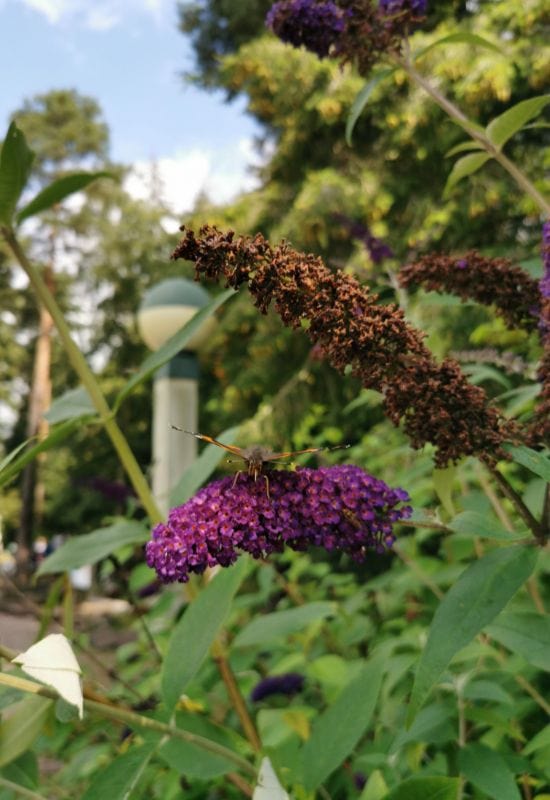
Wait till an inflorescence has wilted, and then nip it off at the base. You can use a small blade to get a neater job, and because some of the petioles can be quite strong; I find a grafting knife ideal for this job.
Basically, keep checking the blossoms of your lilac shrubs regularly, and as soon as any inflorescence becomes unsightly, deadhead it.
So, now we have seen all the things you can do in spring to encourage your lilacs to blossom profusely, we can look at a few other factors that can affect their flowering vigor, and a couple of don’ts.
9: Location, Location, Location: Find the Perfect Place in Your Garden so Your Lilac Shrubs Fill with Flowers!
It may be a bit too late now, but finding a good location for your lilac shrubs is essential to getting lots of flowers from them. The ideal place for Syringa is:
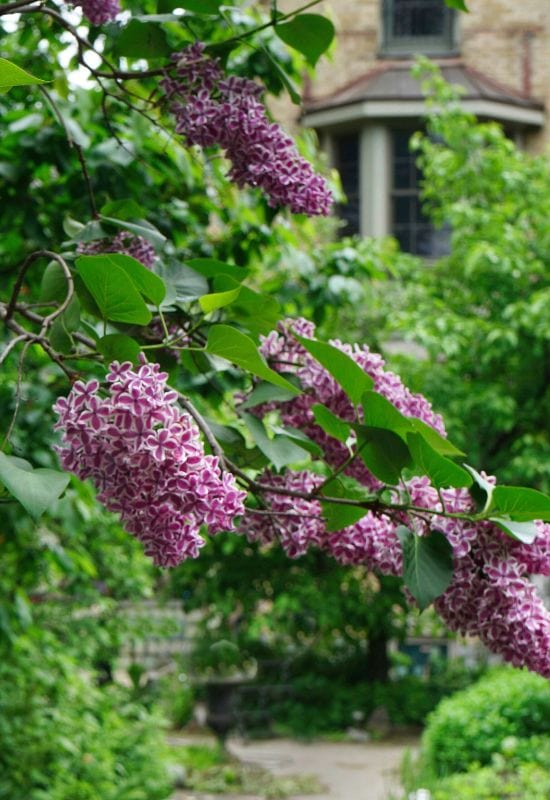
So, for example, an ideal location for your lilac bushes would be against south facing wall, though east and west would do too. But if they have little light, strong winds and poor drainage, they will not flower as much.
But there is little you can do in spring, because you should move lilacs in fall, after they have shed their leaves and before it freezes. But in case they underperform this year because of their position, keep it in mind!
And so, there follows…
10: Do NOT Transplant Your Lilac Shrubs in Spring, or Their Blooms Will Fail!
Just to make it clear, if you transplant your lilac shrubs in spring, you will forsake a good flowering season. They may still give you a few blossoms, but changing site is stressing for them, and they will divert energy from producing buds to roots and leaves.
You can still do it in an emergency, but you will need to give them a full season to recover.
So, now you know all you need to do (and what not to do) in spring to help your lilacs regale you with their impressive blossoms, but you may still have a few questions about some particular problems… Let’s see them, then!
Frequently Asked Questions and Answers on Lilacs and Their Big Blooms
Let’s tie a few final loose ends, a few doubts you may still have about growing lilacs and getting them to blossom profusely, with some clear answers.
Question: “My lilac shrub has a few dead or sick branches, can I prune them in spring, or will it affect its blooming?”
Answer: “If the branches of your lilac shrub are sick or dead, you can cut them – actually you should! It is the only exception to the rule of no pruning in spring. They will not produce many flowers anyway, and they can actually be a waste of energy or, even worse, a threat to the health of your bush!”
Question: “Will my lilac shrubs blossom profusely when they are young?”
Answer: “No, unfortunately, lilac shrubs give you massive blooms, but only once they have established and become adults. It is best to plant them preserving their soil, and even in this case, you may need to wait at least three years for a good flowering display, but if you plant Syringa bare rooted, you can expect to wait in trepidation for 4 to 5 years. You may see a few smaller inflorescences, but nothing major.
Nevertheless, you should still follow the spring instructions, the dos and don’ts we have seen in this article.”
Question: “I have heavy clay or heavy chalk soil, what can I do to get my lilac shrubs to blossom generously?”
Answer: “If your soil is heavy clay or chalk, you must improve it, with organic matter and lots of drainage. An alternative is to grow them in big containers, or on large raised beds, which you can fill with sandy loam.
The good news is that lilac roots are not very deep! They only reach 18 to 24 inches (45 to 60 cm) down, so, an average raised bed will be perfectly fine! But keep topping it up with good soil in fall and spring, because it will wear away.”

Written By
Amber Noyes
Amber Noyes was born and raised in a suburban California town, San Mateo. She holds a master’s degree in horticulture from the University of California as well as a BS in Biology from the University of San Francisco. With experience working on an organic farm, water conservation research, farmers’ markets, and plant nursery, she understands what makes plants thrive and how we can better understand the connection between microclimate and plant health. When she’s not on the land, Amber loves informing people of new ideas/things related to gardening, especially organic gardening, houseplants, and growing plants in a small space.

Very helpful!
I now understand caring for our lilac tree we planted
A couple years ago